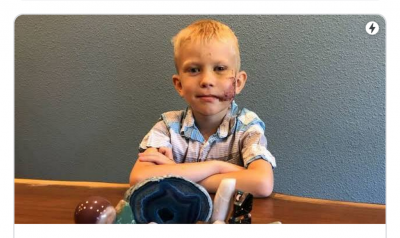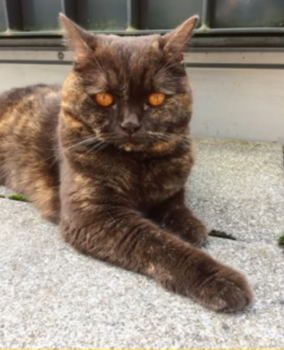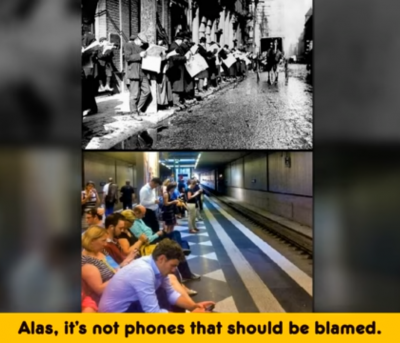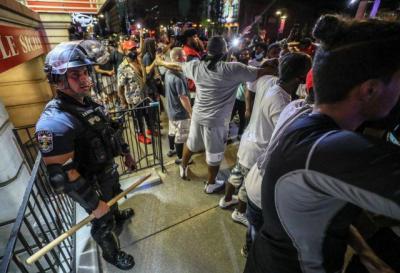-
Posts
3,684 -
Joined
-
Last visited
-
Days Won
55
Content Type
Profiles
Forums
Gallery
Events
Everything posted by Trene4000
-

Pictures That Describe How You Feel
Trene4000 replied to phee's topic in Pictures, Photography and Art
-
By Holly Yan, CNN Updated 3:29 AM ET, Mon July 20, 2020 (CNN)First, health officials said we shouldn't wear face masks. Then, they said we should. Now, many are saying we must wear masks if we want to protect the economy, reopen more schools, and save tens of thousands of lives. "If we all wore face coverings for the next four, six, eight, 12 weeks across the nation, this virus transmission would stop," said Dr. Robert Redfield, director of the Centers for Disease Control and Prevention. It's true that back in February and March, health officials such as Dr. Anthony Fauci and US Surgeon General Dr. Jerome Adams advised the general public not to wear face masks. But Fauci, Adams, the CDC and the World Health Organization have all done an about-face with mask guidance. In recent months, scientists have learned more about how easily this new coronavirus can spread in public: -- This virus can be spread by just talking or breathing -- This coronavirus is highly contagious. Without mitigation efforts like stay-at-home orders, each person with the coronavirus infects an average of two to three other people. That makes it twice as contagious as the flu. -- It's easy to spread the coronavirus without any symptoms -- This virus has a long incubation period -- up to 14 days -- giving a wide window of opportunity for people to infect others before they even know they're infected. -- Carriers may be most contagious in the 48 hours before they get symptoms In other words, it's not just people who are sneezing and coughing who can spread coronavirus. It's often people who look completely normal and don't have a fever. And that could include you. See remainder of story at: https://www.cnn.com/2020/07/19/health/face-masks-us-guidance/index.html
-
Scary Guy, it was supposed to be funny.
-
GOD'S got us covered even when we do stupid.
-
U.S. Rep. John Lewis and Rev. Corey Tindell Vivian presented with the 2010 Medal of Freedom by President Barack Obama. By Faith Karimi, CNN Updated 9:52 AM EDT, Sat July 18, 2020 (CNN)Two towering figures of the American civil rights movement died Friday, a major loss for a nation still grappling with protests and demands for racial equality decades later. John Robert Lewis died at age 80 after a battle with cancer. Rev. Cordy Tindell "C.T." Vivian died at age 95 of natural causes. They died a day before the birthday of the late Nelson Mandela -- another renown champion of racial equality. Both men were the epitome of "good trouble" -- Lewis' favorite saying and approach to confronting injustices without violence. They worked alongside the Rev. Martin Luther King Jr. in the forefront of the historic struggle for racial justices in the 1960s. Full story at: https://www.cnn.com/2020/07/18/us/john-lewis-ct-vivian-dead/index.html
-
John Robert Lewis is an American politician and civil rights leader. He is the U.S. Representative for Georgia's 5th congressional district, serving in his 17th term in the House, having served since 1987, and is the dean of the Georgia congressional delegation. Images of his beating at Selma shocked the nation and led to swift passage of the 1965 Voting Rights Act. He was later called the conscience of the Congress. By Katharine Q. Seelye July 17, 2020 Representative John Lewis, a son of sharecroppers and an apostle of nonviolence who was bloodied at Selma and across the Jim Crow South in the historic struggle for racial equality, and who then carried a mantle of moral authority into Congress, died on Friday. He was 80. His death was confirmed in a statement by Nancy Pelosi, the speaker of the House of Representatives. Mr. Lewis, a Georgia Democrat, announced on Dec. 29 that he had Stage 4 pancreatic cancer and vowed to fight it with the same passion with which he had battled racial injustice. “I have been in some kind of fight — for freedom, equality, basic human rights — for nearly my entire life,” he said. On the front lines of the bloody campaign to end Jim Crow laws, with blows to his body and a fractured skull to prove it, Mr. Lewis was a valiant stalwart of the civil rights movement and the last surviving speaker from the March on Washington for Jobs and Freedom in 1963. More than a half-century later, after the killing in May of George Floyd, a Black man in police custody in Minneapolis, Mr. Lewis welcomed the resulting global demonstrations against police killings of Black people and, more broadly, against systemic racism in many corners of society. He saw those protests as a continuation of his life’s work, though his illness had left him to watch from the sidelines. “It was very moving, very moving to see hundreds of thousands of people from all over America and around the world take to the streets — to speak up, to speak out, to get into what I call ‘good trouble,’” Mr. Lewis told “CBS This Morning” in June. “This feels and looks so different,” he said of the Black Lives Matter movement, which drove the anti-racism demonstrations. “It is so much more massive and all inclusive.” He added, “There will be no turning back.” He died on the same day as did another civil rights stalwart, the Rev. C.T. Vivian, a close associate of the Rev. Dr. Martin Luther King Jr. Mr. Lewis’s personal history paralleled that of the civil rights movement. He was among the original 13 Freedom Riders, the Black and white activists who challenged segregated interstate travel in the South in 1961. He was a founder and early leader of the Student Nonviolent Coordinating Committee, which coordinated lunch-counter sit-ins. He helped organize the March on Washington, where Dr. King was the main speaker, on the steps of the Lincoln Memorial. Mr. Lewis led demonstrations against racially segregated restrooms, hotels, restaurants, public parks and swimming pools, and he rose up against other indignities of second-class citizenship. At nearly every turn he was beaten, spat upon or burned with cigarettes. He was tormented by white mobs and absorbed body blows from law enforcement. On March 7, 1965, he led one of the most famous marches in American history. In the vanguard of 600 people demanding the voting rights they had been denied, Mr. Lewis marched partway across the Edmund Pettus Bridge in Selma, Ala., into a waiting phalanx of state troopers in riot gear. Ordered to disperse, the protesters silently stood their ground. The troopers responded with tear gas and bullwhips and rubber tubing wrapped in barbed wire. In the melee, which came to be known as Bloody Sunday, a trooper cracked Mr. Lewis’s skull with a billy club, knocking him to the ground, then hit him again when he tried to get up. Televised images of the beatings of Mr. Lewis and scores of others outraged the nation and galvanized support for the Voting Rights Act, which President Lyndon B. Johnson presented to a joint session of Congress eight days later and signed into law on Aug. 6. A milestone in the struggle for civil rights, the law struck down the literacy tests that Black people had been compelled to take before they could register to vote and replaced segregationist voting registrars with federal registrars to ensure that Black people were no longer denied the ballot. Once registered, millions of African-Americans began transforming politics across the South. They gave Jimmy Carter, a son of Georgia, his margin of victory in the 1976 presidential election. (A popular poster proclaimed, “Hands that once picked cotton now can pick a president.”) And their voting power opened the door for Black people, including Mr. Lewis, to run for public office. Elected in 1986, he became the second African-American to be sent to Congress from Georgia since Reconstruction, representing a district that encompassed much of Atlanta. ‘Conscience of the Congress’ While Mr. Lewis represented Atlanta, his natural constituency was disadvantaged people everywhere. Known less for sponsoring major legislation than for his relentless pursuit of justice, he was called “the conscience of the Congress” by his colleagues. When the House voted in December 2019 to impeach President Trump, Mr. Lewis’s words rose above the rest. “When you see something that is not right, not just, not fair, you have a moral obligation to say something,” he said on the House floor. “To do something. Our children and their children will ask us, ‘What did you do? What did you say?’ For some, this vote may be hard. But we have a mission and a mandate to be on the right side of history.” His words resonated as well after he saw the video of a Minneapolis police officer kneeling on Mr. Floyd’s neck for more than eight minutes as Mr. Floyd gasped for air. “It was so painful, it made me cry,” Mr. Lewis told “CBS This Morning.” “People now understand what the struggle was all about,” he said. “It’s another step down a very, very long road toward freedom, justice for all humankind.” When he was younger, his words could be more militant. History remembers the March on Washington for Dr. King’s “I Have a Dream” speech, but Mr. Lewis startled and energized the crowd with his own passion. “By the force of our demands, our determination and our numbers,” he told the cheering throng that August day, “we shall splinter the segregated South into a thousand pieces and put them together in the image of God and democracy. We must say: ‘Wake up, America. Wake up!’ For we cannot stop, and we will not and cannot be patient.” His original text was more blunt. “We will march through the South, through the heart of Dixie, the way Sherman did,” he had written. President John F. Kennedy’s civil rights bill was “too little, too late,” he had written, demanding, “Which side is the federal government on?” But Dr. King and other elders — Mr. Lewis was just 23 — worried that those first-draft passages would offend the Kennedy administration, which they felt they could not alienate in their drive for federal action on civil rights. They told him to tone down the speech. Still, the crowd, estimated at more than 200,000, roared with approval at his every utterance. An earnest man who lacked the silver tongue of other civil rights orators, Mr. Lewis could be pugnacious, tenacious and single-minded, and he led with a force that commanded attention. He gained a reputation for having an almost mystical faith in his own survivability. One civil rights activist who knew him well told The New York Times in 1976: “Some leaders, even the toughest, would occasionally finesse a situation where they knew they were going to get beaten or jailed. John never did that. He always went full force into the fray.” Mr. Lewis was arrested 40 times from 1960 to 1966. He was repeatedly beaten senseless by Southern policemen and freelance hoodlums. During the Freedom Rides in 1961, he was left unconscious in a pool of his own blood outside the Greyhound Bus Terminal in Montgomery, Ala., after he and others were attacked by hundreds of white people. He spent countless days and nights in county jails and 31 days in Mississippi’s notoriously brutal Parchman Penitentiary. Once he was in Congress, Mr. Lewis voted with the most liberal Democrats, though he also showed an independent streak. In his quest to build what Dr. King called “the beloved community” — a world without poverty, racism or war (Mr. Lewis adopted the phrase) — he routinely voted against military spending. He opposed the Persian Gulf war of 1991 and the North American Free Trade Agreement, which was signed in 1992. He refused to take part in the “Million Man March” in Washington in 1995, saying that statements made by the organizer, Louis Farrakhan, leader of the Nation of Islam, were “divisive and bigoted.” In 2001, Mr. Lewis skipped the inauguration of George W. Bush, saying he thought that Mr. Bush, who had become president after the Supreme Court halted a vote recount in Florida, had not been truly elected. In 2017 he boycotted Mr. Trump’s inauguration, questioning the legitimacy of his presidency because of evidence that Russia had meddled in the 2016 election on Mr. Trump’s behalf. That earned him a derisive Twitter post from the president: “Congressman John Lewis should spend more time on fixing and helping his district, which is in horrible shape and falling apart (not to mention crime infested) rather than falsely complaining about the election results. All talk, talk, talk — no action or results. Sad!” Mr. Trump’s attack marked a sharp detour from the respect that had been accorded Mr. Lewis by previous presidents, including, most recently, Barack Obama. Mr. Obama awarded Mr. Lewis the Presidential Medal of Freedom, the nation’s highest civilian honor, in 2011. In bestowing the honor in a White House ceremony, Mr. Obama said: “Generations from now, when parents teach their children what is meant by courage, the story of John Lewis will come to mind — an American who knew that change could not wait for some other person or some other time; whose life is a lesson in the fierce urgency of now.” To His Family, ‘Preacher’ John Robert Lewis grew up with all the humiliations imposed by segregated rural Alabama. He was born on Feb. 21, 1940, to Eddie and Willie Mae (Carter) Lewis near the town of Troy on a sharecropping farm owned by a white man. After his parents bought their own farm — 110 acres for $300 — John, the third of 10 children, shared in the farm work, leaving school at harvest time to pick cotton, peanuts and corn. Their house had no plumbing or electricity. In the outhouse, they used the pages of an old Sears catalog as toilet paper. John was responsible for taking care of the chickens. He fed them and read to them from the Bible. He baptized them when they were born and staged elaborate funerals when they died. “I was truly intent on saving the little birds’ souls,” he wrote in his memoir, “Walking With the Wind” (1998). “I could imagine that they were my congregation. And me, I was a preacher.” His family called him “Preacher,” and becoming one seemed to be his destiny. He drew inspiration by listening to a young minister named Martin Luther King on the radio and reading about the 1955-56 Montgomery bus boycott. He finally wrote a letter to Dr. King, who sent him a round-trip bus ticket to visit him in Montgomery, in 1958. By then, Mr. Lewis had begun his studies at American Baptist Theological Seminary (now American Baptist College) in Nashville, where he worked as a dishwasher and janitor to pay for his education. In Nashville, Mr. Lewis met many of the civil rights activists who would stage the lunch counter sit-ins, Freedom Rides and voter registration campaigns. They included the Rev. James M. Lawson Jr., who was one of the nation’s most prominent scholars of civil disobedience and who led workshops on Gandhi and nonviolence. He mentored a generation of civil rights organizers, including Mr. Lewis. Mr. Lewis’s first arrest came in February 1960, when he and other students demanded service at whites-only lunch counters in Nashville. It was the first prolonged battle of the movement that evolved into the Student Nonviolent Coordinating Committee. David Halberstam, then a reporter for The Nashville Tennessean, later described the scene: “The protests had been conducted with exceptional dignity, and gradually one image had come to prevail — that of elegant, courteous young Black people, holding to their Gandhian principles, seeking the most elemental of rights, while being assaulted by young white hoodlums who beat them up and on occasion extinguished cigarettes on their bodies.” In three months, after repeated well-publicized sit-ins, the city’s political and business communities gave in to the pressure, and Nashville became the first major Southern city to begin desegregating public facilities. See following for entire story: https://www.nytimes.com/2020/07/17/us/john-lewis-dead.html
-
By Chloe Melas, CNN Updated 10:01 AM EDT, Thu July 16, 2020 (CNN) Bridger Walker, a brave 6-year-old boy from Wyoming, has gained social media notoriety after being praised by Anne Hathaway for rescuing his sister from a dog attack. On July 9, Bridger jumped into action when a 1-year-old old German shepherd mix charged toward his 4-year-old sister, a statement from the family obtained by CNN states. While shielding his sister he was brutally attacked by the dog. "Tragically, instead of running off, the dog leaped and latched onto Bridger's cheek," the statement reads in part. Bridger subsequently underwent a two-hour surgery that required more than 90 stitches, according to his family. And when his father asked him why he jumped in between his sister and the dog, he is said to have told them, "if someone had to die, I thought it should be me," according to the statement. The young boy's aunt started an Instagram page and shared that Bridger is an Avengers fan, which caught Hathaway's attention. "I'm not an Avenger, but I know a superhero when I see one," Hathaway wrote on Instagram alongside photos of Bridger and his sister. "I can only hope I'm half as brave in my life as you are in yours, Bridger. Wishing you an easeful recovery, and many cool looking rocks. Hey @markruffalo, do you need a teammate??" Cast members from the popular franchise have yet to comment publicly, but Hathaway's post has garnered more than 1 million likes and thousands of comments praising the boy. The family also says Ruffalo, Tom Holland, Hugh Jackman, Zachary Levi, the Russo brothers and Robbie Amell are among those who have reached out to them. "May we follow Bridger's example, approach the world as a child, and bring greater peace to our own homes, communities, states and countries," the family concluded in their statement. CNN's Justin Lear contributed to this report.
-
I find that as my age increases, my tolerance for stupid people decreases.
-
It's a trick!!! It's a trick!!! Cats are neither stupid nor lazy. They're days are shorter than ours. They can chase off bears and alligators. They attack their enemies' eyes, blinding them. They are clever enough to fool humans into thinking they're stupid and manipulate us into doing a multitude of things for them.
-
GOD cannot possibly Love you more than HE already does, because HE Loves you absolutely.
-
By Brooke Singman | Fox News Published June 17, 2020 Michigan Gov. Gretchen Whitmer said Wednesday she will extend the state’s coronavirus state of emergency, which was set to expire Friday. Whitmer said during a press conference that Michigan “will remain in some form of a state of emergency order.” “All 50 states are in some form of state of emergency and we will have to be as well,” Whitmer added. The state of emergency for Michigan is not the same as the state’s stay-at-home order, which was lifted earlier this month. Whitmer touted the state’s new coronavirus data, noting that it shows that Michigan’s “aggressive actions” have lowered the positive COVID-19 cases and deaths. “The data shows that very few states dropped their infection rates as low as Michigan has,” she said. “Only Michigan and New York are on track to contain COVID-19.” Meanwhile, Whitmer on Wednesday also announced that Michigan schools may resume in-person learning in phase 4 of the state's reopening plan. Whitmer said that on June 30 she will release an executive order and a document called “Michigan’s Return to School Roadmap” which will provide details on what will be required and what will be recommended for schools. Whitmer also highlighted the need for support and flexibility from the federal government to help ensure resources for students and educators. “Our students and educators have made incredible sacrifices these past few months to protect themselves and their families from the spread of COVID-19,” Whitmer said in a statement Wednesday. “Thanks to our aggressive action against this virus, those who have done their part to flatten the curve, and the heroes on the front lines, I am optimistic that we will return to in-person learning in the fall.” “Schools must make sure to enact strict safety measures to continue protecting educators, students, and their families,” she added. “I will continue working closely with the Return to Learn Advisory Council and leaders in health care to ensure we get this right, but we also need more flexibility and support from the federal government. This crisis has had serious implications on our budget, and we need federal support if we’re going to get this right for our kids.” Whitmer said she will consider the state’s “Safe Start Plan” and determine “when, where and how face-to-face instruction can resume.” The Roadmap, according to Whitmer’s office, will set the minimum health and safety requirements, while districts may choose to enact more aggressive ones in consultation with local public health officials. The requirements, according to Whitmer’s office, will apply to all schools, including traditional public, charter, private and parochial schools. As of Wednesday, Michigan reported more than 65,600 total positive cases of COVID-19 and more than 5,900 deaths since the pandemic began. Story located: https://www.foxnews.com/politics/whitmer-to-extend-michigans-state-of-emergency-amid-coronavirus
-
-
-
'They saved me': How protesters protected a lone cop Michael Clevenger, Louisville Courier Journal June 6, 2020, 7:12 PM EDT LOUISVILLE, Ky. – Officer Galen Hinshaw heard the call over the radio. One of his fellow officers was in trouble. A crowd of protesters had surrounded a police cruiser at the base of the Clark Memorial Bridge. The officer inside radioed for help as protesters — strobed in blue and red patrol car lights — banged on the car’s hood and windshield. Hinshaw, a Fourth Division patrol officer and part of Louisville Metro Police Department's Special Response Team, drove as close as he could to the scene. As he got out of his cruiser, he was immediately surrounded by protesters. Some yelled profanities. Others balled their fists. He made his way through the crowd wearing 40 extra pounds of safety gear — a baton, vest, helmet and body armor. He was alone. As the crowd grew, Hinshaw detoured to the front of Bearno’s pizzeria so he could keep his back to the wall. He needed a place to stop and reassess the situation — to be sure that nobody could get behind him. He also needed to keep an eye on his trapped colleague. Overhead, a police helicopter kept watch and occasionally flooded the intersection with a spotlight. Sirens pierced the air, and protesters chanted ever louder. Hinshaw’s nearest help was still blocks away. The crowd moved closer, and the yelling got angrier. Protesters hurled questions at him. "Are you one of the good ones?" "How do you think we feel?" One women screamed, "All gas, no brakes!" He tried to respond but was drowned out by the cacophony of sirens and yelling. “We do care, man, we do care,” he said. Hinshaw tried to reason with the crowd. “I’m sorry, I’m sorry you feel this way,” Hinshaw yelled, trying to make his voice heard over the anger of the crowd. The 32-year-old was scared. It was only going to take one person, and everyone would jump in, he knew. The Special Response Team trains once a month, but that hadn’t quite prepared Hinshaw for what was in front of him. If the protesters decided to attack him, there were just too many of them. “Here we go,” he thought. “I’m preparing to be injured.” Hinshaw kept his voice calm as he radioed in: “Charlie 12, this is a 10-30. We need help.” 10-30 is code for officer needs help. He watched people's hands in the crowd, making sure nobody had a weapon and scanning for things thrown from protesters in the back. It was at this moment that a man emerged from the crowd in a red University of Louisville mask covering the lower half of his face. He put himself between the closest protester and Hinshaw. The Courier Journal captured the moment in a photograph that has now been shared across the nation. Local entrepreneur Darrin Lee Jr. spotted Hinshaw and the advancing crowd and linked arms with the stranger in the red mask. “Once I saw the guy with the red mask step up, I said, 'I gotta step up,'” said Lee, who also runs a child care center. “It was reactive. I just went.” He had no idea what would happen next. “I really thought at that moment, 'Protect him. It really isn’t his fault.'" Lee said. Lee was also worried that Hinshaw would react and hit him from behind, so he turned to reassure the officer that they were going to protect him. “He was looking nervous and scared,” Lee said. “If he panicked, then there was gonna be a war out there.” Suddenly, the protesters seemed to turn on Lee. One man who had marched with him for nearly the whole protest was surprised. Another shouted in Lee's face: "How can you protect him!" Lee got nervous. Ultimately, five men formed a human shield to protect Hinshaw. All of them strangers to one another. Nobody knew the name of the man to his left or to his right. Three were black, one white, one Dominican — all linking arms to keep harm away from Hinshaw, himself half-Pakistani. “A human was in trouble, and right is right," said Ricky McClellan, a factory worker from Old Louisville who was locked onto Lee’s left arm. After reaching the bridge and watching some protesters throwing rocks at police cars, McClellan spotted Hinshaw as he walked around the group and thought, "Whoa, you're by yourself?" McClellan watched as the crowd around Hinshaw grew larger and louder. Then he heard Lee yell, “Lock arms! Lock arms!” That's when Julian De La Cruz saw the men locking arms and jumped in. “I saw the guys link up and I saw a weak spot,” De La Cruz said, and took up a position on the end of the line. He was nervous, scared. “Things could’ve gotten really bad,” he said. The entire scene lasted no more than two minutes. It felt much longer to those who were there. Hinshaw's squad arrived, and Lee escorted him back to his unit. Hinshaw thanked him. For De La Cruz, a local businessman, the moment was about accountability. “If I can hold my brothers accountable, if I can march with my brothers and turn against them to say, 'This isn’t right,' that’s where the accountability comes in,” he said. “In the end, that’s all that we are asking for," said De La Cruz, whose uncle is a police officer. "What we need is for those great cops to hold their brothers and sisters accountable at all times.” As proud as De La Cruz is of that night, he shakes his head and says that this shouldn’t be an extraordinary event. “This should be the norm,” he said. De La Cruz also feels that media images of violence, vandalism and looting misrepresent Louisville and the protest. “What happened that night with us linking arms was just one of many heroic acts that night," he said. He hopes that those are the moments that define Louisville. "That is Louisville," De La Cruz said. "Louisville showed up that night." Lee agreed. “Nobody knew anybody but we just stood up and did that,” he said. “If the officer was black we would’ve done the same thing. He’s somebody else’s son. He’s somebody else’s loved one." Hinshaw has reached out to the men through social media and texts. But he's looking forward to meeting them all and thanking them in person. George Timmering, co-owner of Bearno's, said he'll buy the pizza when they're ready to meet. “Those guys, they saved me,” Hinshaw said. “There’s no doubt about it. And I am beyond thankful. If it wasn’t for them intervening and recognizing that I was in trouble and helping me, I am sure that I would’ve been assaulted in one form or another. "If they didn’t intervene, something was gonna happen to me.” Hinshaw continues to be moved by the moment. “I’ve cried over that incident," he said. “It was a moment where strangers came together to help another stranger, and that stranger was me.” Follow Michael Clevenger on Twitter: @mclevenger_cj This article originally appeared on Louisville Courier Journal: Breonna Taylor protests: Protesters protected lone Louisville officer The version I read was here: https://news.yahoo.com/saved-protesters-protected-lone-cop-231203138.html?.tsrc=daily_mail&uh_test=2_13
-
Following a National Geographic inquiry, the zoo confirms that four more tigers and three lions have the virus. This comes the same day as two pet cats in New York become the first in the U.S. to test positive. PUBLISHED APRIL 22, 2020 FOUR MORE TIGERS and three lions at the Bronx Zoo in New York City have tested positive for the virus that causes COVID-19, the zoo announced Wednesday afternoon, following a National Geographic inquiry. This comes nearly three weeks after one tiger at the zoo was confirmed to have the virus and six other cats were said to be exhibiting symptoms. The diagnosis of the tiger, named Nadia, represented “the first time, to our knowledge, that a [wild] animal has gotten sick from COVID-19 from a person,” Paul Calle, chief veterinarian for the Bronx Zoo, said April 5. The big cats likely contracted the coronavirus from an infected but asymptomatic zookeeper whose identity is unknown, Calle says: “It’s the only thing that makes sense.” Calle says. The zoo has been closed to visitors since March 16. Initially it did not plan to test the other cats showing symptoms, because doing so would require sedation, which can be dangerous. But the U.S. Department of Agriculture subsequently updated an online database with information that a lion in New York had also been confirmed as testing positive for the virus on April 15. National Geographic contacted the Bronx Zoo seeking more information on April 22. And shortly thereafter the Wildlife Conservation Society, the nonprofit that runs the Bronx Zoo, issued a press release announcing that four additional tigers and three lions had tested positive. The zoo confirmed in the press release that the additional tests were done using fecal samples and did not require sedation. It is not clear when the additional tests on the three lions and four tigers were conducted or when the zoo received the results; a zoo spokesperson did not respond to questions about the timing. The USDA did not respond to National Geographic’s request for comment by press time. Several domestic animals have tested positive for SARS-CoV-2, the virus that causes COVID-19, including two cats in New York State—the first in the United States, the USDA announced today. A Pomeranian and a German shepherd in Hong Kong, as well as a domestic cat in Belgium, have also tested positive. The U.S. Centers for Disease Control and Prevention today issued new guidelines on the virus for pet owners, saying that while it does not recommend widespread testing at this time, it encourages cat owners to keep their cats indoors whenever possible.
-
GOD Loves you because you are.
-
Well, Disney has finally sold out.
-
FCC launches web page with coronavirus fraud safety tips by Katherine Skiba, AARP, March 23, 2020 Scammers out to make a quick buck during the coronavirus pandemic are using robocalls to tout bogus cures and fake test kits, the federal government warns. The illicit conduct — which also includes text messaging — has bad actors preying on people's fears while anxiety over COVID-19 is high. With a jump in scam phone calls and texts during the pandemic, the government has launched a web page with safety tips for consumers. The site, fcc.gov/covid-scams, was created by the Federal Communications Commission (FCC). LISTEN TO ACTUAL CORONAVIRUS SCAM CALLS If you visit the website, you can hear audio from actual scams, including: Fraudsters pushing free home testing kits. Scams targeting diabetics who require insulin. Services that purport to clean heating, ventilation and air-conditioning (HVAC) systems. With telecommuting on the rise, anecdotally it seems more and more people are being bombarded with unsolicited robocalls — some related to the pandemic, and others not. People also have reported an opposite problem: Their caller ID displays “spam” or “scam” yet the call is legitimate. That's likely based on their individual telephone carrier's system for labeling incoming calls, or could relate to the operating system of a particular device such as an iPhone, an FCC spokesman says. Contact your telecom provider for more information. The FCC says it receives consumer complaints and monitors news reports and consumer alerts from other federal government agencies. "We're tracking scams and sharing information to arm consumers about how impostors use spoofing and other tactics to steal their money and their identity,” says Patrick Webre, chief of the FCC's Consumer and Governmental Affairs Bureau. With caller ID spoofing, bad actors disguise the actual phone number used to place the call and substitute a number that is not theirs. UPDATES ON NEWLY EMERGING SCAMS The FCC urges people to check its COVID-19 Consumer Warnings and Safety Tips web page for updates as new scams surface. For more about scam calls and texts, visit the FCC Consumer Help Center and the FCC Scam Glossary. You also may file a complaint about such scams at fcc.gov/complaints. fcc.gov/covid-scams https://consumercomplaints.fcc.gov/hc/en-us
-
Jerks...
-
-
It cracks me up about this stupid Bambi eye commercial. They're showing the women putting on that mascara to make their eyelashes very long like Bambi supposedly but they keep showing Faline who was the doe. Anybody who's ever seen the movie Bambi would know that Bambi was a buck. He did not have long eyelashes. Faline did.


















